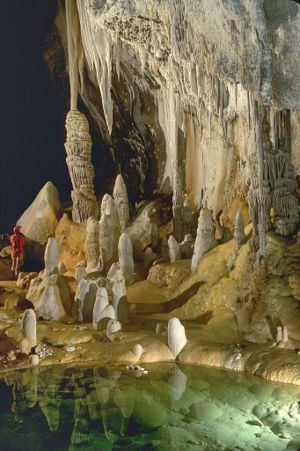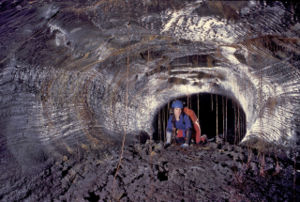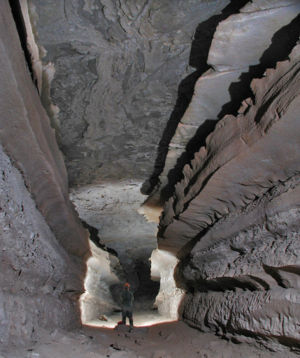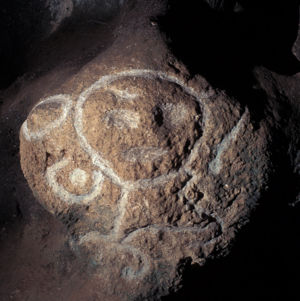Cave
2007 Schools Wikipedia Selection. Related subjects: Geology and geophysics
A cave is a natural underground void large enough for an adult human to enter. Some scientists stipulate that it must be large enough that some portion of it will not receive daylight; however, in popular usage, the term includes smaller spaces like cliff cavities, rock shelters and sea caves. Speleology is the scientific exploration and study of all aspects of caves. The act of exploring a cave for recreation is called " caving", "potholing", or occasionally (only in the United States) " spelunking".
Types and formation
Caves are formed by geologic processes. These may involve a combination of chemical processes, erosion from water, tectonic forces and atmospheric influences.
Primary caves
Some caves are formed at the same time as the surrounding rock. These are called primary caves.
- Lava tubes are formed through volcanic activity. They are the most common primary caves. Lava flows downhill and the surface cools and solidifies. The lava now flows under this crust, until the eruption ends. If the liquid lava inside the crust flows out, a hollow tube remains.
The most important lava tubes are found on Hawaii ( Big Island). Kazumura Cave near Hilo is the longest and deepest lava tube of the world and also the eighth longest cave of the United States.
- Blister caves are also formed through volcanic activity.
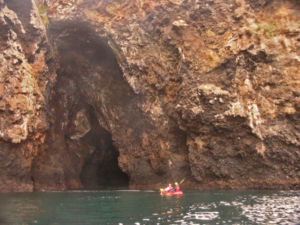
Secondary caves
Secondary caves are formed inside the rock after the rock itself has formed by processes such as solution and erosion.
- Sea caves are very common along coasts around the world. Also known as littoral caves, they form from wave action along zones of weakness in sea cliffs. Most commonly these are faults, but may also be dikes or bedding plane contacts. Some wave-cut caves are now high and dry due to uplift. Conversely, in places like Thailand's Phang Nga Bay, solutional caves have been flooded by the sea and are now subject to littoral erosion. Sea caves are generally rather small but may exceed 300 meters in length. One of the largest concentrations of large sea caves is found on Santa Cruz Island in California.
- Glacier caves occur in ice and under glaciers, formed by melting. They are also influenced by the very slow flow of the ice which tends to close the caves again. (These are sometimes called ice caves, though this term is properly reserved for caves which contain year-round ice formations).
- Solutional caves may form anywhere with rock which is soluble, and are most prevalent in limestone, but can also form in other material, including chalk, dolomite, marble, granite, salt, sandstone, fossilized coral and gypsum. The most common process of cave formation is karstification, which is the solution of rocks by rain water.
- Fracture caves are formed when layers of more soluble minerals such as gypsum dissolve out from between layers of less soluble rock. These rocks fracture and collapse in blocks.
- Talus caves are the openings between rocks that have fallen down into a pile, often at the bases of cliffs.
The largest and most abundant solutional caves are located in limestone. Limestone dissolves under the action of rainwater and groundwater charged with H2CO3 ( carbonic acid) and naturally occurring organic acids. The dissolution process produces a distinctive landform known as karst, characterized by sinkholes, sinking streams, and underground drainage. Limestone caves are often adorned with calcium carbonate formations produced through slow precipitation, including the most common and well-known stalactites and stalagmites. These secondary mineral deposits in caves are called speleothems. The world's most spectacularly decorated cave is generally regarded to be Lechuguilla Cave ( New Mexico, USA).
Lechuguilla and nearby Carlsbad Caverns are now believed to be examples of another type of solutional cave. They were formed by acid rising from below, where reservoirs of oil give off sulfurous fumes, rather than by acidic water percolating from the surface.
Distribution and Records
Caves are found throughout the world, but only a portion of them have been explored and documented by cavers. The distribution of documented cave systems is widely skewed toward countries where caving has been popular for many years (such as the United States, France, Italy, the UK etc.). As a result, explored caves are found widely in Europe, Asia, North America, and Oceania but are sparse in South America, Africa, and Antarctica. This is a great generalization, as large expanses of North America and Asia contain no documented caves, whereas areas such as the Madagascar dry deciduous forests and parts of Brazil contain many documented caves. As the world’s expanses of soluble bedrock are researched by cavers, the distribution of documented caves is likely to shift. For example China, despite containing around half the world's exposed limestone - more than 1,000,000 km² - has relatively few documented caves.
The system with the greatest total length of passage is Mammoth Cave ( Kentucky, USA) at 579 km in length. This record is unlikely to be surpassed in the near future as the next most extensive known cave is the Optymistychna system in Ukraine, at 214 km.
As of 2005, the deepest known cave (measured from its highest entrance to its lowest point) is Voronya Cave (Abkhazia, Georgia), with a depth of 2,140 m. This was the first cave to be explored to a depth of more than 2 km. (The first cave to be descended below 1 km was the famous Gouffre Berger in France). The Gouffre Mirolda - Lucien Bouclier cave in France (1733 m) and the Lamprechtsofen Vogelschacht Weg Schacht in Austria (1632 m) are the current second and third deepest caves. This particular record has changed several times in recent years.
The deepest individual pitch (vertical drop) within a cave is 603 m in the Vrtoglavica cave in Slovenia, followed by Patkov Gušt (553 m) in the Velebit mountain, Croatia.
The largest individual cavern ever discovered is the Sarawak Chamber, in the Gunung Mulu National Park ( Sarawak, Borneo, Malaysia), a sloping, boulder strewn chamber with an area of approximately 600 m by 400 m and a height of 80 m.
Since new caves are continually being explored, the various records of cave dimensions need to be updated fairly frequently.
For information on a specific cave, see list of caves.
Inhabitants
Cave-inhabiting animals are often categorized as troglobites (cave-limited species), troglophiles (species which can live their entire lives in caves, but also occur in other environments), trogloxenes (species which use caves, but cannot complete their life cycle wholly in caves) and accidentals (animals not in one of the previous categories). Some authors use separate terminology for aquatic forms (e.g., stygobites, stygophiles, and stygoxenes).
Of these animals, the troglobites are perhaps the most unusual organisms. Troglobitic species often show a number of characteristics, termed troglomorphies, associated with their adaptation to subterranean life. These characteristics may include a loss of pigment (often resulting in a pale or white coloration), a loss of eyes (or at least of optical functionality), an elongation of appendages, and an enhancement of other senses (such as the ability to sense vibrations in water). Aquatic troglobites (or stygobites), such as the endangered Alabama cave shrimp, live in bodies of water found in caves and get nutrients from detritus washed into their caves and from the faeces of bats and other cave inhabitants. Other aquatic troglobites include cave fish and the Olm.
Bats, such as the Gray bat and Mexican Free-tailed Bat, are trogloxenes and are often found in caves; they forage outside of the caves. Some species of cave crickets are classified as trogloxenes, because they roost in caves by day and forage above ground at night.
Because of the fragile nature of the cave ecosytem, and the fact that cave regions tend to be isolated from one another, caves harbour a number of endangered species, such as the Tooth cave spider, Liphistiidae Liphistius trapdoor spider and the Gray bat.
Caves are visited by many surface-living animals, including humans. These are usually relatively short-lived incursions, due to the lack of light and sustenance.
Some tropical caves of southeast Asia are rich in cave fauna and some even have cave flora
Archaeological and social importance
Throughout history, primitive peoples have made use of caves for shelter, burial, or as religious sites. Since items placed in caves are protected from the climate and scavanging animals, this means caves are an archaeological treasure house for learning about these people. Cave paintings are of particular interest. One example is the Great Cave of Niah, which contains evidence of human habitation dating back 40,000 years.
In Germany some experts found signs of cannibalism in the caves at the Hönne.
Caves are also important for geological research because they can reveal details of past climatic conditions in speleothems and sediment layers.
Caves are frequently used today as sites for recreation. Caving, for example, is the popular sport of cave exploration. For the less adventurous, a number of the world's prettier and more accessible caves have been converted into show caves, where artificial lighting, floors, and other aids allow the casual visitor to experience the cave with minimal inconvenience. Caves have also been used for BASE jumping and cave diving.
